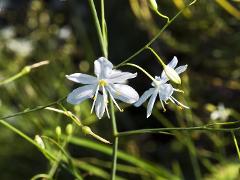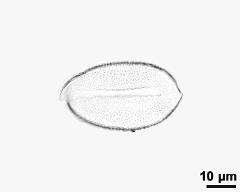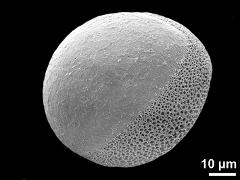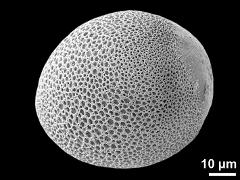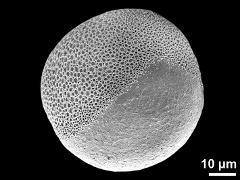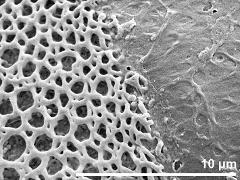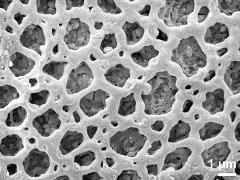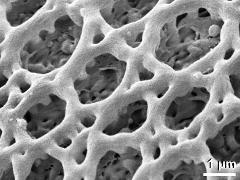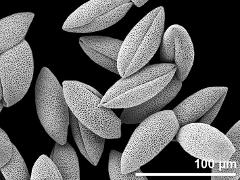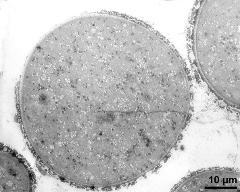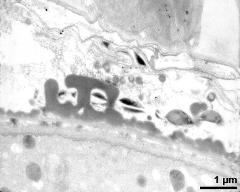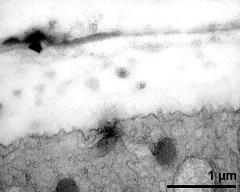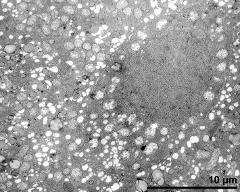Anthericum ramosum
Taxonomy: Angiospermae, Asparagales, Amaryllidaceae, Anthericum
Published: 2016-10-18
Pollen Description
Shape, Size and Aperture
pollen unit: monad, dispersal unit and peculiarities: monad, size (pollen unit): large (51-100 µm), size of hydrated pollen (LM): -, shortest polar axis in equatorial view (LM): -, longest polar axis in equatorial view (LM): -, shortest diameter in equatorial or polar view (LM): -, longest diameter in equatorial or polar view (LM): -, pollen class: sulcate, polarity: heteropolar, P/E-ratio: oblate, shape: -, outline in polar view: elliptic, dominant orientation (LM): -, P/E-ratio (dry pollen): -, shape (dry pollen): boat-shaped, outline in polar view (dry pollen): elliptic, infoldings (dry pollen): aperture(s) sunken, aperture number: 1, aperture type: sulcus, aperture condition: sulcate, aperture peculiarities: -
Ornamentation and Structure
LM ornamentation LM: reticulate, nexine: -, sexine: -, SEM ornamentation SEM: heterobrochate, reticulate, suprasculpture SEM: -, TEM tectum: semitectate, infratectum: columellate, foot layer: discontinuous, endexine: compact-discontinuous, intine: monolayered, wall peculiarities: -, supratectal element: -
Miscellaneous
pollen coatings: pollenkitt, reserves in cytoplasm: lipids, cell number: 2-celled, Ubisch bodies: present
Author(s) of diagnosis: Aktuna, Gabriela; Halbritter, Heidemarie; Weber, Martina
Pictures
Picture legend
- flower(s), photographer: Buchner, R.
- pollen grain after acetolysis - fresh, acetolyzed, unstained, photographer: Aktuna, G.
- polar distal view (oblique) - fresh, rehydrated (water) & critical point dried & sputter coated with gold, photographer: Halbritter, H.
- polar proximal view - fresh, rehydrated (water) & critical point dried & sputter coated with gold, photographer: Halbritter, H.
- equatorial view - fresh, rehydrated (water) & critical point dried & sputter coated with gold, photographer: Halbritter, H.
- sulcus border - fresh, rehydrated (water) & critical point dried & sputter coated with gold, photographer: Halbritter, H.
- exine surface - fresh, rehydrated (water) & critical point dried & sputter coated with gold, photographer: Halbritter, H.
- exine surface - fresh, rehydrated (water) & critical point dried & sputter coated with gold, photographer: Halbritter, H.
- dry pollen grains - dry, sputter coated with gold, photographer: Halbritter, H.
- pollen grain in cross section - fresh, glutaraldehyde & osmium & potassium ferrocyanide, uranyl acetate & lead citrate, photographer: Aktuna, G.
- interapertural area of pollen wall - fresh, glutaraldehyde & osmium & potassium ferrocyanide, uranyl acetate & lead citrate, photographer: Aktuna, G.
- apertural area of pollen wall - fresh, glutaraldehyde & osmium & potassium ferrocyanide, modified Thiéry-test, photographer: Aktuna, G.
- generative cell - fresh, glutaraldehyde & osmium & potassium ferrocyanide, lipid-test, photographer: Aktuna, G.
Literature
- (1994) Exkursionsflora von Österreich : 1180
- (1998) Preparing living pollen material for scanning electron microscopy using 2,2-dimethoxypropane (DMP) and criticalpoint drying. Biotechnic Histochem 73: 137–143
Copyright and Citation
Cite this publication as:
Aktuna G., Halbritter H., Weber M., Buchner R. 2016. Anthericum ramosum. In: PalDat - A palynological database. https://pc8.botanik.univie.ac.at/pub/Anthericum_ramosum/301570; accessed 2025-01-10

